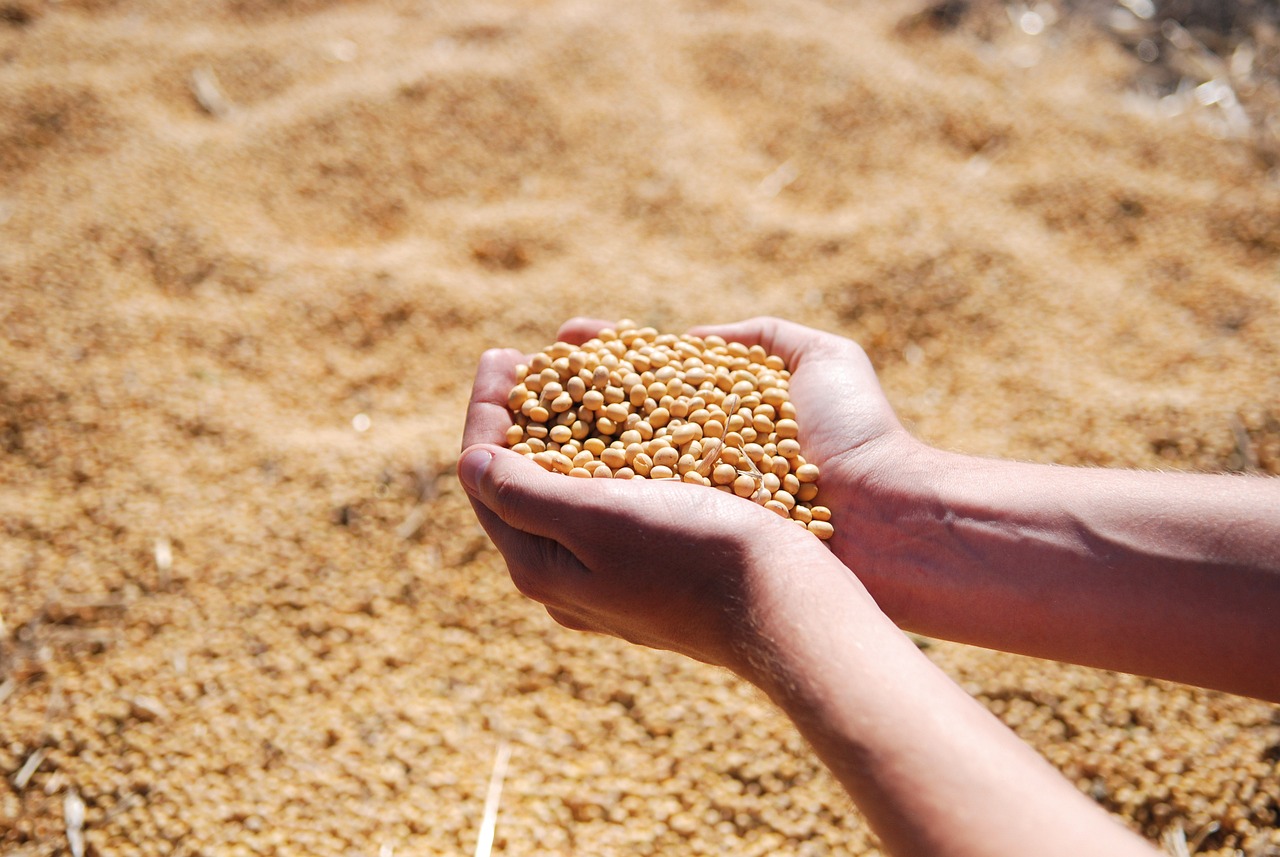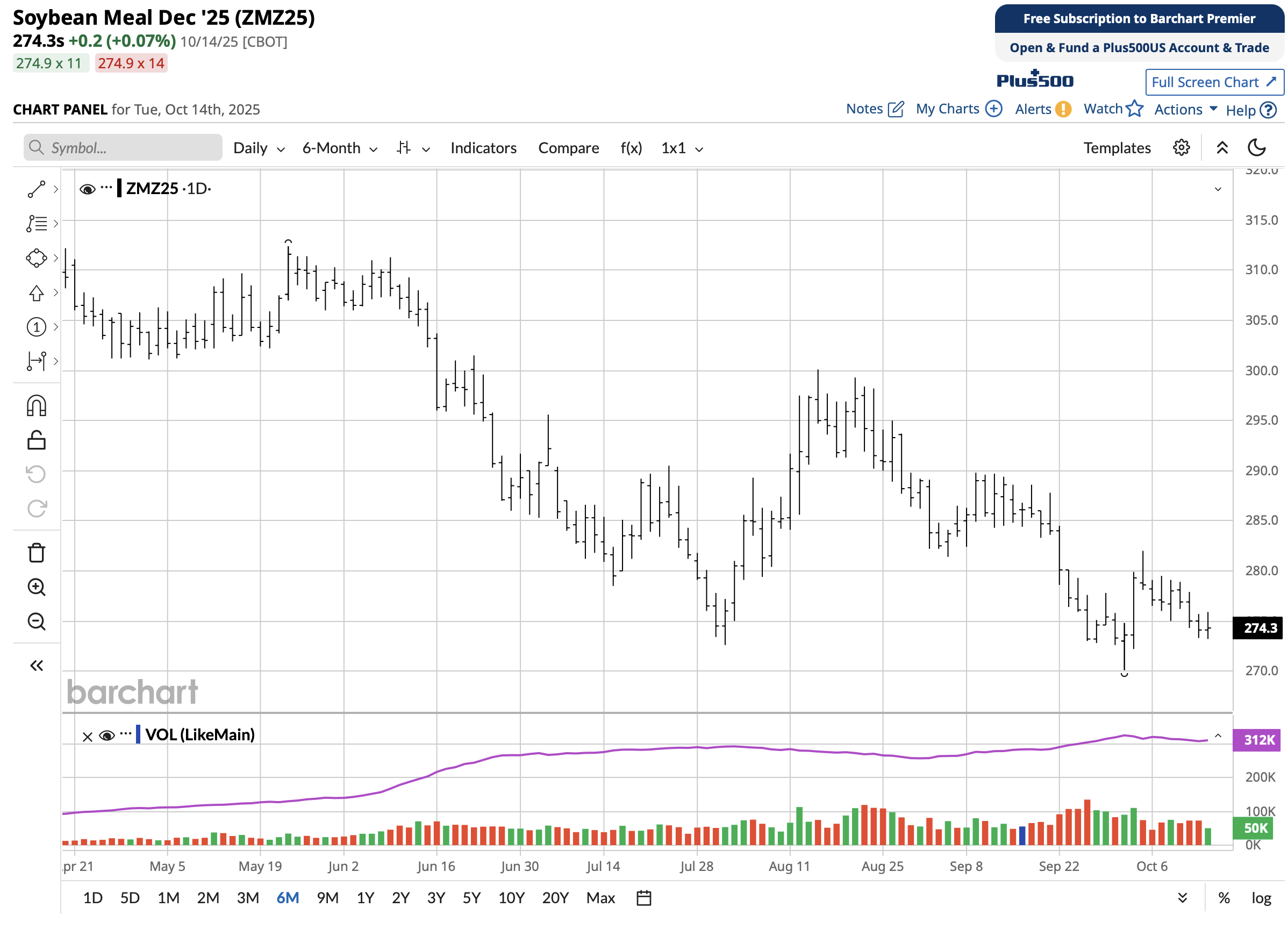Soybean Harvest Winds Down, Soybean Meal Prices Go Up

I am Stephen Davis, senior market strategist at Walsh Trading, Inc., Chicago, Illinois. You can reach me at 312-878-2391 and sdavis@walshtrading.com.
In a September 17 Market Outlook report from the U.S. Department of Agriculture Economic Research Service, the Market Year (MY) 2025/26 soybean season-average farm price forecast is lowered by 10 cents to $10 per bushel. The soybean meal and soybean oil prices are forecast to be unchanged, at $280 per short ton and 53 cents per pound, respectively.
Soybean crush is raised to 2.56 billion bushels, on higher soybean meal demand. The American Soybean Association (ASA) informs us that soybeans are almost never used whole but are instead “crushed” to produce soybean meal and soybean oil. The ASA reports that approximately 80% of the crushed bean results in soybean meal, which is used for protein content in livestock feed, and hulls. The other 20 percent is soybean oil, which is primarily used for human consumption and biofuels.
The USDA National Agricultural Statistics Service’s (NASS) Crop Production report in September indicated the marketing year (MY) 2025/26 soybean production is at 4.3 billion bushels, 8.0 million bushels higher than the previous month’s forecast. The production forecast is raised on higher acreage. More recent updates are not available from the USDA due to the government shutdown.
However, the National Oilseed Processors Association (NOPA) Monthly Crush Report report is due to be released tomorrow, October 15. The report details monthly soybean crush and oil stocks for NOPA's 18 member companies, accounting for more than 97% of the U.S. soybean crush.
This chart for December soybean meal attracted my attention. Today, October 14, the market took out the yesterday's low and high. It didn't close on the extreme high yet, in my opinion, prices will go higher. Stochastics hover in the middle but are shifting up, which could support a move higher if resistance levels are wiped out.

A trade strategy is to buy December 2025 soybean meal at 274.30 which is today's settlement price. Risk the trade to 269.30 stop, good until cancelled. Profit objective for the trade is 284.30. You are risking $500 per contract to make $1,000. I like the 1 to 2 ratio.
Notice on the chart below that the high on September 22 was 284.50 so the price has been at our profit objective. There is quite a range of estimates on U.S. soybean harvest progress. Due to the government shutdown, the most recent USDA Crop Progress Report is from September 29 – too long ago to reflect current conditions. The NOPA report will be the one to watch.
The market is likely waiting for confirmation of a U.S-China trade meeting. Headline watching suggests increasing volatility coming up to November 1 deadline for an additional 100 percent tariff on China. It's always good idea to trade with stop-loss orders, especially with USA-China trade negotiations hanging in the balance.
An option strategy is to sell two December 2025 soybean meal 270 puts at 3.45 (today's settlement price). With that premium in your account, buy one March 2026 soybean meal 290 call at 8.70. The December soybean meal options expire November 21, 2025. The March 2026 soybean meal options expire February 20, 2026.
I like this option strategy because you won't get stopped out and if and when soybean meal trades higher, you will be rewarded.
Stephen Davis
Senior Market Strategist
Walsh Trading
Direct 312 878 2391
Toll Free 800 556 9411
sdavis@walshtrading.com
www.walshtrading.com
Use this link to join my email list: SIGN UP NOW

Walsh Trading, Inc. is registered as a Guaranteed Introducing Broker with the Commodity Futures Trading Commission and an NFA Member.
Futures and options trading involves substantial risk and is not suitable for all investors. Therefore, individuals should carefully consider their financial condition in deciding whether to trade. Option traders should be aware that the exercise of a long option will result in a futures position. The valuation of futures and options may fluctuate, and as a result, clients may lose more than their original investment. The information contained on this site is the opinion of the writer or was obtained from sources cited within the commentary. The impact on market prices due to seasonal or market cycles and current news events may already be reflected in market prices. PAST PERFORMANCE IS NOT NECESSARILY INDICATIVE OF FUTURE RESULTS. All information, communications, publications, and reports, including this specific material, used and distributed by Walsh Trading, Inc. (“WTI”) shall be construed as a solicitation for entering into a derivatives transaction. WTI does not distribute research reports, employ research analysts, or maintain a research department as defined in CFTC Regulation 1.71.
